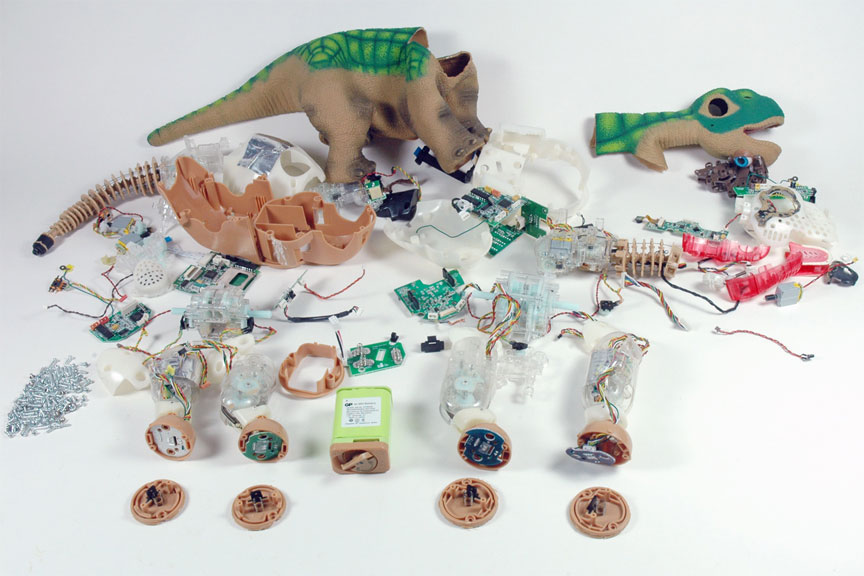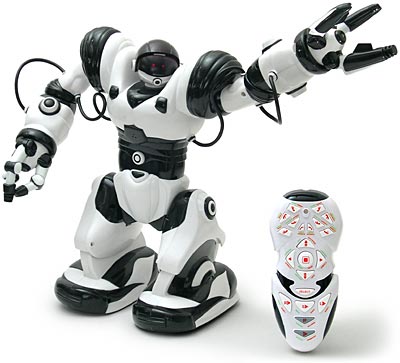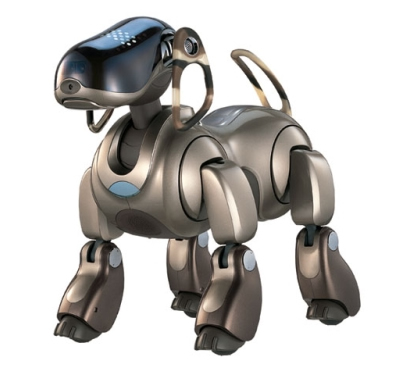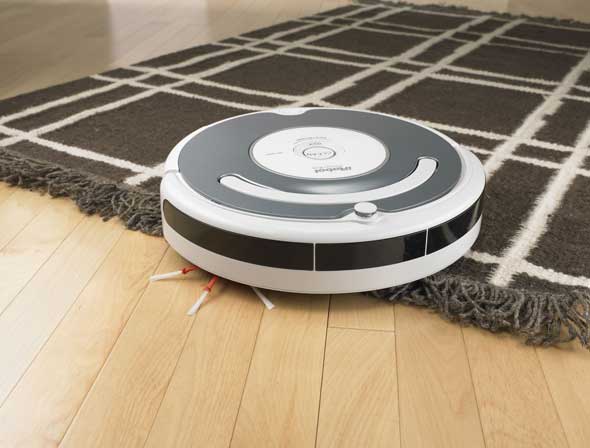Top 10 Robots of the Past 10 Years - Robots of the Decade Awards

As we say goodbye to the 200x's and welcome the 201x's it's good to pause a bit and think about the world as it was ten years ago. There was no Wikipedia, no YouTube, internet access was still dialup for a huge portion of the population, and we didn't have a whole heap of really cool robots. To highlight some of the great inventions of the past ten years, we've selected 10 of the best robots fom the past 10 years.
With any sort of list like this, things are pretty arbitrary, but we tried to pick robots that have made an impact in our culture or have impacted the hobby or science of robots in a major way. Below you'll find 10 amazing robots from the military, toy industry, consumer industry, and science community that have had a lasting impact on robotics.
Take a look and tell us what you think. If you had to nominate 10 robots of the decade, who would they be? Keep reading for our picks for robots of the decade.
KeepOn (2007 - present)
KeepOn took the online world by storm in March of 2007 when Marek Michalowski, a graduate student at Carnegie Mellon University, uploaded a film of KeepOn dancing to Spoon's, "I Turn My Camera On". The catchy beat plus KeepOn's utter adorableness prompted over 2 million people to watch the video. KeepOn then went on to star in a WIRED sponsored music video featuring Spoon's, "Don't You Evah". This video garnered another million plus views. KeepOn is hard to describe, other than "incredibly cute", and it's still stunning how lifelike and emotive two squishy stacked balls with googly-eyes can be.
[youtube http://www.youtube.com/watch?v=nPdP1jBfxzo&hl=en_US&fs=1&]
Developed by Hideki Kozima, a researcher in cognitive science at Miyagi University in Japan, KeepOn was designed to be an interactive toy to study, "social development and interpersonal coordination as well as in therapeutic practice for children with developmental disorders such as autism". He features two cameras behind his eyes that allow a researcher or doctor to observe a patient interact with the robot, without being directly involved. KeepOn's disarming charm and personality allow a broad range of interaction that might be impossible between a normal adult and a child with autism.
KeepOn makes the "Top Robots of the past 10 Years" list simply because of his amazing ability to charm his way into mainstream culture.
PackBot (2001 - present)

iRobot's PackBot saw its first real action in the aftermath of the September 11th attacks, as it searched through the rubble of the World Trade Center towers in New York City. The US Military also used them shortly thereafter in Afghanistan to search caves and buildings for insurgents, and to investigate anti-personnel mines. The military quickly realized the usefulness of such a tool and the number of PackBots in use has grown to over 2,000 (iRobot's site says 2,500 currently in use).
Due to the huge number of road-side bomb attacks in Iraq, iRobot developed an Explosive Ordinance Disposal (EOD) package for the PackBot and quickly became a strong competitor in the EOD arena, competing against the much larger and older TALON robots by Foster-Miller. EOD soldiers tended to prefer the PackBot to the TALON due to its more intuitive and responsive controls.
The PackBot's distinctive design, fast speed, and ruggedness have made it a favorite of robot builders and military personnel alike. Its unique flippers allow it to climb obstacles, right itself, and increase its height to peer over small walls. It can also be carried in a backpack and can be submerged in water. The PackBot has starred in a music video, been recreated with LEGO bricks, and featured in dramatic intellectual property lawsuit.
iRobot's PackBot makes the list of important robots from the past decade because of its extensive use in the Iraq war, the number of lives it has saved, and the intense bond that soliders form with it while performing operations.
Pleo (2007 - present)
At the DEMO event in 2006 an amazing robot named Pleo was unveiled by Caleb Chung, the creator of the Furby (actually, maybe Furby should be on this list too!). Chung promised a successor to the unbelievably popular Furby, which sold 27 million units in one 12 month period. Pleo was supposed to supersede Furby's ability to learn and interact with its users while adding the ability to move around by walking.
Pleo was originally announced to cost $200 and be released around Christmas 2006. Both numbers quickly slipped and Pleo was finally released in December of 2007 for a cost of over $300! Amidst all the hype around Pleo, sales were sluggish and Pleo mainly appealed to the techno-savvy crowd. Promises of a Pleo software development kit were delayed, and while Pleo owners were overwhelmingly positive about Pleo, Ugobe (Pleo's parent company) was never able to convince the average consumer they needed one. In fact, Ugobe really didn't know how to market Pleo at all. By late 2008 the global economy effectively shut down the company and the IP was auctioned off in April of 2009. Amazingly enough, though, the IP to Pleo was purchased by Jetta Company Limited who announced that they would continue to sell and develop Pleo.

Pleo's amazing firebird-like story and his continued popularity with owners, children, the elderly, and robot builders put him on this list of top robots from the past 10 years. No one has successfuly produced a consumer product that is so sophisticated, intricate and accessible to the average person. Pleo's future looks bright as long as Jetta can nail down a target market and successfully advertise Pleo. Educational and hobbiest development looks promising too.
BigDog (2005 - present)

Boston Dynamics calls BigDog, "the most advanced rough-terrain robot on earth." If you asked someone on the street about BigDog, they'd probably say, "oh yeah! That really creepy looking walking robots. That's awesome!" While Boston Dynamics claim may certainly be true, the incredible reaction from the general public is the main reason you're seeing this robot on this list.
Released in 2005, BigDog was designed using funding from the Defense Advanced Research Projects Agency, or DARPA, and was created to serve as a "pack mule" for a solider in the battle field. The robot is about the size of a large dog and can carry a load of up to 340 pounds (150 kg) at 4 miles/hr while climbing over rough terrain and steep inclines. The success of the robot, and most of the creepy charm, comes from its ability mimic the walking motion of real animals. Its design absorbs shock, and recycles energy from one step to the next. It also has an onboard LIDAR and stereo vision system for navigation.
Video of an updated version of BigDog was released in 2008 and has been watched by nearly 10 million people. BigDog's ability to recover from a kick, and walking on icy surfaces is simply amazing.
[youtube http://www.youtube.com/watch?v=W1czBcnX1Ww&hl=en_US&fs=1&]
BigDog makes this list of robots of the decade because its amazing engineering impresses not only robot lovers, but the general public as well. It even inspired a very funny prody video, with nearly 3 million views.
RoboSapien (2003 - present)

RoboSapien was a unique robotic toy released in 2003. Produced by an obscure Hong Kong based toy manufacturer named WowWee, the $100 walking, talking, robot was a smash hit. For those in the BEAM Robotics community, perhaps the release wasn't such a surprise, as Mark Tilden, the father of the BEAM field, had quit his job at Los Alamos National Laboratory and moved to Hong Kong to work on robot toys. The RoboSapien quickly won a whole slew of awards and sold close to 2 million units. WowWee released a RoboSapien V2 toy in 2005, and many more toys in the "Robo" lineup.
One of the most unique features of the RoboSapien, and a large portion in its continued popularity, is the intentional "hackability" built into the toy. Tilden designed the toy so that it could be easy modified, and was easy to understand once taken apart. Built on Tilden's BEAM principles, the RoboSapien was amazingly versatile with just a few motors and sensors.

RoboSapien makes the list of important robots over the past ten years because of its numerous awards, large sales volume and immediate recognition by the average member of the public. WowWee proved that advanced and innovative robots could also be cool and a viable consumer product.
ASIMO and Honda P-Series (2000 - present)

Asimo is the 11th in a line of walking robots developed by Honda, called the P-Series. Unveiled in 2000, Asimo could walk and run like a human, which was an amazing feat. ASIMO had a significant upgrade in 2005, that allowed him to run twice as fast (6 km/hr or 4.3mph), interact with humans, and perform basic tasks like holding a platter and serving food. The current ASIMO models number about 100 worldwide, stand 4.2 feet tall, and weight about 120 lbs.

ASIMO, with his space-suit looking appearance, is cheerful and endearing. He has paved the way for many subsequent walking, human-like robots, but still holds his own as an advanced and powerful robot. ASIMO is a great boon to Honda's global branding, and helps the company's appearance of innovation and technology. ASIMO has also appeared in commercials for Honda, like this one, has his own website, and makes many celebrity appearances. A YouTube video showing ASIMO's 2005 upgrade has had over 2.5 millions views.
ASIMO makes this list because of his winsome appearance, world-wide recognition, and advanced technology.
Aibo (1999 - 2006)

2006 was the year that robot dogs died, when Sony shut down its popular and sophisticated robotics divsion. Started in 1999, Sony produced the very popular Aibo robot dog, which quickly became a favorite robot of dog lovers and high-rolling robot builders alike. Sony developed the robots through three generations and garnered a large following of devoted developers.

Aibo was also the star of the RoboCup's "robot dog soccer" category, where teams of Aibo's would compete in a soccer match. With the demise of the Aibo, RoboCup searched for a replacement and selected Aldebaran Robotic's Nao platform. Estimated sales for Aibo were somewhere around 150,000 units.
Aibo makes the list of robots of the decade because of its continued popularity, numerous uses in research, and tearful story of corporate robo-execution.
Predator Drone (1996 - present)

The Predator drone has been in existence since 1996, but has risen to prominence thanks to the events of September 11, 2001 and consequent wars. Prior to 2001 the unmanned vehicle was strictly for reconnaissance, when it was retrofitted to be armed with hellfire missiles. The Predator Drone has since then been used in countless operations, like this one, and has logged nearly one million hours of flight time. The number of drones used by the Department of Defense has grown from 300 in 2002 to 7,000 in 2009.
The drone, which was developed by the secretive General Atomics company, has flown combat missions in several foreign countries, and is extensively used by the US military in the war in Afghanistan. The Predator's low airspeed makes it nearly invisible to ground troops, and advanced camera's and optics allow the ground-based operator to obtain high-resolution images of the ground below.

Most of the Predators are controlled via ground-based troops stationed in Southern California, and the drones are controlled via military satellite links. The video downlink feeds can be access by troops in the field, or by insurgents themselves, as the video feeds aren't encrypted.
The Predators make this list because they have been instrumental in saving hundreds of soldier's lives over the course of the past 10 years. It can only be left to the imagination how difficult the operations in Iraq and Afghanistan would have been without powerful air-based surveillance by these robots.
LEGO Mindstorms (1998 - present)

If you were a robot builder or a LEGO fan in 1998, the biggest news of the year was the release of LEGO's LEGO Mindstorms RIS product. It was revolutionary for a strictly toy company to unveil an advanced robotics platform that appealed to hobbyists, educators, and children alike. The first set, the RIS 1.0 sold well and LEGO released a RIS 2.0 kit shortly thereafter. The RIS set was wildly successful (LEGO's best selling product) and spawned a huge variety of projects, books, and various compilers. The RIS also had its own competition, the FIRST Lego League competition.
For eight years the set remained substantially the same, while the rest of the world made huge progress in computing power and robotics technology. Then, in early 2006, LEGO announced the creation of a brand new and completely re-imaged Mindstorms kit called "LEGO Mindstorms NXT". The new kit featured a powerful processor, bluetooth connectivity, a LABView-based programming environment, and several new sensors. The motors in the kit were also significantly upgraded to allow for speed control or position control - a major difficulty in designing robots for the RIS. The kit was released to the public in July of 2006 and was praised as a great addition to the Mindstorms lineup. Amazingly enough, LEGO had designed the new set in a mere eleven months, with the close help from a team of its biggest Mindstorms fans. Mindstorms NXT 2.0 was released in the summer of 2009 and continues to sell well.

LEGO Mindstorms NXT (and RIS) make this list because it has introduced millions of children to the world of robotics. While RIS was relased over 12 years ago, the NXT release in 2006 once again kicked off a flurry of books and innovative creations that excite and inspire. I firmly believe that the world will be a better place 20 or 30 years from now because so many were inspired by the Mindstorms kits and went on to do great things.
Roomba (2002 - present)

It's awful hard to remember back to 2001 when the dream of floor cleaning robots was still just that - a dream of housewives and robo-fanboys everywhere. iRobot took the household cleaning market by storm when it released its first commercial floor cleaning robot, called the Roomba, in 2002. By 2004 the Roomba had sold 1 million units, when a second generation model was released, the Roomba Discovery series. iRobot has since gone on to release a 3rd generation model in 2007, and a floor scrubbing robot, Scooba. To date 2.5 million Roombas have been sold.

The Roomba makes the list because my grandmother has one. Any robot that can be operated and loved by a technophobe is a rare find and worth celebrating. SNL also did a very funny parody of Roomba, called the "Woomba".
Onward To The Next 10 Years ...
So, there you have it. The 10 most important robots of the past ten years. What do you think? Are there any robots I left off or any robots you think shouldn't be on this list? It's been a pretty busy 10 years for robotic innovation, so I don't doubt there's plenty more than I could have listed. Here's to ten great years of robot goodness and high hopes for ten more!
Thanks for helping to keep our community civil!
This post is an advertisement, or vandalism. It is not useful or relevant to the current topic.
You flagged this as spam. Undo flag.Flag Post




